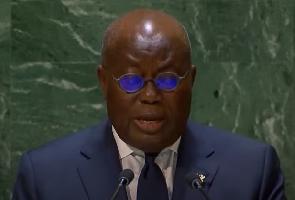 President Nana Addo Dankwa Akufo-Addo
President Nana Addo Dankwa Akufo-Addo
President Akufo-Addo has emphasized the vital role of Ghana's youth in sustaining the nation's agriculture sector, stressing the government's reliance on their vibrancy, fresh ideas, and innovation to enhance the country's collective prosperity.
Speaking at the presidential conference on the "Youth in Agriculture" initiative held at the Cedi Conference Centre, University of Ghana on October 18, 2023, he made a passionate appeal to both educated and uneducated young Ghanaians to embrace agriculture as a lifelong vocation.
According to President Akufo-Addo, "Sustaining Ghana's agriculture is dependent on the youth. The youth are the future of this country, and we count on their vibrancy, fresh ideas, and innovation to improve our collective fortune."
He also highlighted the design of the "Youth in Agriculture" program, which focuses on value-chain development, offering expanded opportunities for the youth to contribute to the agricultural sector. The President encouraged young people to unite around this initiative, form cooperatives, and seek partnerships to maximize its benefits.
Economic Recovery and Inflation Trends
President Akufo-Addo also addressed the state of the Ghanaian economy and the efforts made by his administration to achieve economic stability and growth. He pointed out that there are clear indications of an economic rebound, as evidenced by a downward trend in inflation.
"The prospects for the rebound are growing stronger and stronger. We are working hard to sustain this momentum. Inflation has reduced from 54.1% in December 2022 to 38.1% in September, and there is every indication that by the end of the year, it will be around 27%. By the end of my tenure next year, 15%," the President stated.
Youth in Agriculture Initiative's Ambitious Goals
The Minister for Food and Agriculture, Bryan Acheampong, outlined the ambitious goals of the "Youth in Agriculture" initiative, which is part of the second phase of the Planting for Food and Jobs (PFJ) program. This initiative aims to make agriculture more accessible to the youth and provides an alternative to traditional, labor-intensive farming methods.
“Our invitation to young people to go into agriculture is not a hole and cutlass business. Through the collaboration between the Ministry of Food and Agriculture and the YEA under the banner, 'PFJ 2.0 Youth in Agriculture,' we are going to put 200,000 youth into permanent work in agriculture, with each individual cultivating an average farm size of 10 acres," Bryan Acheampong said.
He further emphasized that this initiative could put 400,000 hectares of arable land into cultivation. The primary crops targeted for production include maize, rice, and vegetables, with the potential to exceed food self-sufficiency production targets.
Youth in Agriculture Programme's Objectives
The Youth in Agriculture Programme (YIAP) is a government initiative aimed at motivating young people to see farming and food production as viable commercial ventures. This initiative seeks to provide various benefits to the youth, including employment opportunities, access to tractor services and agro-inputs, and improved income. Furthermore, it aims to encourage young people to remain in rural areas, with the provision of inputs at their farm gates on a credit basis, interest-free.
The Youth in Agriculture Programme has four key components: Crops/Block Farm, Livestock and Poultry, Fisheries/Aquaculture, and Agribusiness. It is open to individuals, groups, and institutions interested in farming and agricultural training.
The government is committed to promoting youth involvement in agriculture, recognizing their potential to drive the country's agricultural sector to new heights. With the "Youth in Agriculture" initiative, Ghana is taking a significant step toward a more vibrant and sustainable agricultural future.